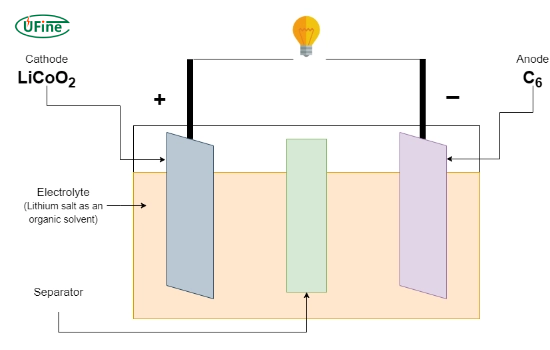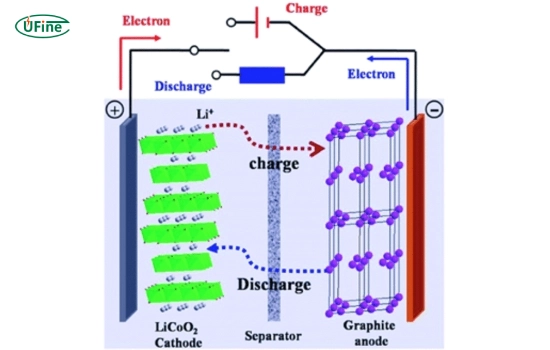One technology that has gained significant attention is the Licoo2 battery, a lithium-ion battery known for its impressive energy density and performance. This article will explore what Licoo2 batteries are, how they work, their advantages and disadvantages, and their various applications in our daily lives. Whether you’re a tech enthusiast or simply curious about battery technology, this guide will provide valuable insights into the fascinating world of Licoo2 batteries.
Part 1. What is a Licoo2 battery?
A LiCoO2 battery is a rechargeable lithium-ion battery that utilizes lithium cobalt oxide (LiCoO2) as its cathode material. Known for its high energy density, this type of lithium-ion battery is highly efficient and is commonly used in applications requiring compact yet powerful energy storage, including electric vehicles and consumer electronics. The Licoo2 battery is known for its ability to deliver a consistent voltage and relatively long cycle life compared to other battery types.
Part 2. How does a Licoo2 battery work?
The operation of a LiCoO2 battery involves several key components that contribute to its impressive energy density and long cycle life. During the charging process, lithium ions move from the cathode to the anode, making this battery ideal for energy-intensive applications such as electric vehicles and portable electronics.
- Anode: Typically made from graphite, the anode stores lithium ions during the charging process.
- Cathode: The lithium cobalt oxide (LiCoO2) serves as the cathode, releasing lithium ions during discharge.
- Electrolyte: A lithium salt dissolved in an organic solvent facilitates the movement of lithium ions between the anode and cathode.
When a LiCoO2 battery is charged, lithium ions move from the cathode to the anode through the electrolyte. During discharge, the process reverses, and the ions flow back to the cathode, generating electrical energy.
Part 3. Advantages and disadvantages of Licoo2 batteries
LiCoO2 batteries offer remarkable advantages, especially for high-performance applications such as electric vehicles and smartphones. However, it’s important to weigh their cost, thermal stability, and environmental concerns when deciding on the best battery solution for your needs.
Advantages
- High Energy Density: Licoo2 batteries have a high energy-to-weight ratio, allowing devices to run longer on a single charge. This makes them ideal for portable electronics and electric vehicles.
- Stable Voltage Output: These batteries maintain a consistent voltage throughout their discharge cycle, providing reliable performance, which is crucial for sensitive electronic devices.
- Long Cycle Life: With proper care, Licoo2 batteries can endure hundreds of charge and discharge cycles, making them cost-effective.
- Lightweight: The compact design of Licoo2 batteries contributes to their lightweight nature, which is particularly beneficial for mobile devices and applications where weight is a critical factor.
Disadvantages
- Cost: Producing LiCoO2 batteries can be expensive because cobalt, which miners often extract under challenging conditions, makes these devices pricier.
- Thermal Stability: While generally safe, Licoo2 batteries can pose risks of overheating and thermal runaway if not managed correctly. This necessitates the use of advanced battery management systems.
- Environmental Concerns: The mining and disposal of cobalt raise environmental and ethical concerns. As the demand for batteries increases, sustainable materials sourcing becomes increasingly essential.
Part 4. Applications of Licoo2 batteries
LiCoO2 batteries are widely used in high-demand applications such as electric vehicles (EVs), consumer electronics like smartphones and laptops, and even medical devices. Their high energy density and long cycle life make them suitable for these applications where reliability and performance are key.
- Consumer Electronics: Laptops, smartphones, and tablets commonly use Licoo2 batteries due to their high energy density.
- Electric Vehicles (EVs): Many electric vehicles utilize Licoo2 batteries for their efficiency and performance.
- Power Tools: Cordless power tools benefit from the lightweight and high-capacity nature of Licoo2 batteries.
- Medical Devices: Some medical equipment relies on Licoo2 batteries for reliable and portable power.
Part 5. How to care for Licoo2 batteries?
One should follow proper care guidelines to maximize the lifespan and performance of LiCoO2 batteries.
- To avoid Overcharging, Use a compatible charger. Please do not leave the battery plugged in for extended periods after fully charging.
- Store Properly: If not used, store the battery in a cool, dry place and maintain a charge between 40% and 60%.
- Monitor Temperature: Keep the battery away from extreme temperatures, as overheating can lead to damage.
- Regular Use: Use the battery regularly to prevent it from going into deep discharge, which can harm its capacity.
Part 6. Licoo2 battery vs. other lithium-ion batteries
When comparing LiCoO2 batteries to other lithium-ion chemistries, such as lithium iron phosphate (LiFePO4) and lithium manganese oxide (LiMn2O4), several differences in energy density, cycle life, and cost-effectiveness emerge. LiCoO2 batteries are favored for their high energy density in applications like electric vehicles and portable electronics, where space and weight are critical.
Key Comparisons
- Energy Density: Licoo2 batteries are known for their high energy density, typically ranging from 150 to 200 Wh/kg. In contrast, lithium iron phosphate (LiFePO4) batteries have a lower energy density of around 90 to 120 Wh/kg, making Licoo2 batteries more suitable for compact and lightweight applications.
- Cycle Life: Licoo2 batteries generally offer a cycle life of 500 to 1,500, depending on usage and care. LiFePO4 batteries can last up to 2,000 cycles or more, making them ideal for applications where longevity is critical.
- Thermal Stability: Licoo2 batteries have moderate thermal stability, which can lead to risks of overheating under certain conditions. On the other hand, lithium iron phosphate batteries exhibit high thermal stability, making them safer for applications in extreme conditions.
- Cost: Licoo2 batteries tend to be more expensive due to the high cost of cobalt. In contrast, LiFePO4 batteries are generally more affordable, making them a popular choice for budget-conscious applications.
- Environmental Impact: Cobalt mining for Licoo2 batteries raises significant environmental and ethical concerns. In contrast, LiFePO4 batteries utilize iron, which is more abundant and has a lower environmental impact.
Comparison of LiCoO2 vs. Other Lithium-Ion Battery Chemistries
|
Feature |
Licoo2 Battery |
Lithium Iron Phosphate (LiFePO4) |
Lithium Manganese Oxide (LiMn2O4) |
|
Energy Density |
150-200 Wh/kg |
90-120 Wh/kg |
100-150 Wh/kg |
|
Cycle Life |
500-1,500 cycles |
Up to 2,000 cycles |
500-1,000 cycles |
|
Thermal Stability |
Moderate |
High |
Moderate |
|
Cost |
High |
Moderate |
Moderate |
|
Environmental Impact |
Significant concerns |
Lower impact |
Moderate |
Part 7. FAQs
-
What is the lifespan of a Licoo2 battery?
The lifespan of a Licoo2 battery can vary depending on usage and care, but it typically lasts between 500 and 1,500 charge cycles. -
Are Licoo2 batteries safe to use?
Yes, Licoo2 batteries are generally safe when used correctly. However, they should be monitored for overheating and charged with compatible chargers. -
Can Licoo2 batteries be recycled?
Yes, Licoo2 batteries can be recycled. You should follow local battery disposal and recycling regulations to minimize environmental impact. -
What is the difference between LiCoO2 and other lithium-ion battery chemistries?
LiCoO2 is known for its high energy density, making it ideal for applications requiring compact, long-lasting batteries, like electric vehicles. In contrast, LiFePO4 has a lower energy density but offers superior thermal stability and longer cycle life. -
Are LiCoO2 batteries used in electric vehicles?
Yes, LiCoO2 batteries are widely used in electric vehicles due to their high energy density, providing longer driving ranges and more efficient energy storage. -
What devices commonly use LiCoO2 batteries?
LiCoO2 batteries are commonly found in smartphones, laptops, electric vehicles, and consumer electronics. -
How do I know if my Licoo2 battery is failing?
Reduced runtime, swelling, or overheating are signs of a failing Licoo2 battery. If you notice these symptoms, it may be time to replace the battery.
Related Tags:
More Articles

How to Choose the Best Floor Scrubber Battery for Commercial Cleaning?
Selecting the ideal floor scrubber battery ensures a long runtime, rapid charging, and minimal maintenance for efficient commercial cleaning operations.
Battery for Blower vs Battery for Leaf Vacuum: Which One Should You Choose?
Battery for blower vs leaf vacuum—learn the key differences in power, fit, and runtime to choose the right battery for your outdoor tool needs.
How to Choose the Right Battery for Blower?
Choosing the right blower battery? Consider voltage, capacity, chemistry & usage. This guide helps match the best battery for peak performance.
How to Choose the Best Insulated Battery Box for Lithium Batteries?
Choosing the Best Insulated Battery Box for Lithium Batteries? Discover key factors such as size, material, and safety for optimal protection and performance.
7 Critical Elements on a Lithium Battery Shipping Label
What must be on a lithium battery shipping label? Learn 7 key elements to ensure safety, legal compliance, and correct handling across all transport modes.





